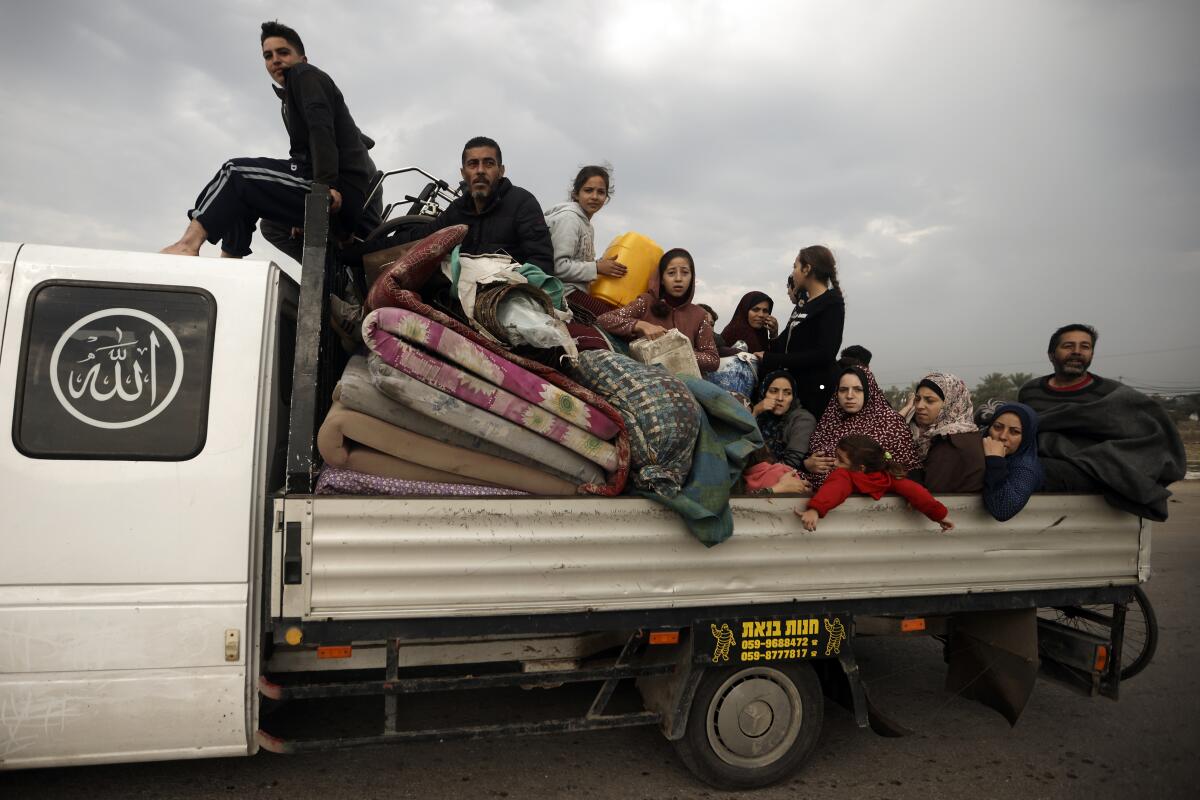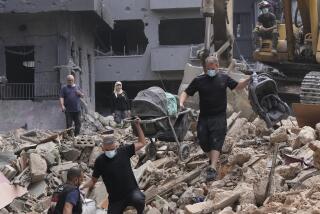Thousands flee widening Israeli assault in central Gaza as military launches new strikes

DEIR AL BALAH, Gaza Strip â Thousands of Palestinian families fled Wednesday from the brunt of Israelâs expanding ground offensive into Gazaâs few remaining, overcrowded refuges, as the military launched heavy strikes across the center and south of the territory, killing dozens, Palestinian health officials said.
On foot or riding donkey carts loaded with belongings, a stream of people flowed into Deir al Balah â a town that normally has a population of around 75,000. It has been overwhelmed by several hundred thousand people driven from northern Gaza as the region was pounded to rubble.
Because U.N. shelters are packed many times over capacity, the new arrivals set up tents on sidewalks for the cold winter night. Most crowded onto streets around the townâs main hospital, Al Aqsa Martyrs, hoping it would be safer from Israeli strikes.
Still, no place is safe in Gaza. Israeli offensives are crowding most of the population into Deir al Balah and Rafah at the territoryâs southern edge as well as a tiny rural area by the southern coastline. But those areas continue to be hit by Israeli strikes that regularly crush homes full of people.
The newly displaced were fleeing several built-up refugee camps in central Gaza targeted in the latest phase of Israelâs ground assault. One of the camps, Bureij, came under heavy bombardment throughout the night as Israeli troops moved in.
âIt was a night of hell. We havenât seen such bombing since the start of the war,â said Rami Abu Mosab, speaking from Bureij, where he has been sheltering since fleeing his home in northern Gaza.
He said warplanes flew overhead, and gunfire and explosions echoed from the eastern edge of the camp. A home near his shelter was hit, but no one was able to reach the area, he said.
Bureij camp, like others in Gaza, houses refugees from the 1948 war surrounding Israelâs creation and their descendants and now resembles other densely populated neighborhoods.
With much of northern Gaza leveled, Palestinians fear a similar fate awaits other areas, including Khan Yunis, just south of Deir al Balah, where Israeli forces launched ground operations in early December.
In Khan Yunis, Israeli shelling Wednesday struck a residential building next to Al Amal Hospital, according to the Palestinian Red Crescent, which runs the facility.
Health Ministry spokesman Ashraf al Qidra said at least 20 people were killed and dozens more wounded, with the death toll likely to rise. Footage from the scene showed several torn bodies lying in the street as rescue workers loaded a man whose legs had been severed below the knees onto a stretcher.
Israel has said the bombing campaign and ground offensive are necessary to dismantle Hamas and prevent a repeat of its Oct. 7 attack in which militants broke through Israelâs formidable defenses and killed some 1,200 people â mostly civilians â and abducted around 240. An estimated 129 remain in captivity after dozens were freed.
Achieving its goals, Israel has said, will take âmany months.â
Israelâs offensive is already one of the most devastating military campaigns in recent history. More than 21,100 Palestinians, most of them women and children, have been killed, including nearly 200 people in the last 24 hours, according to the Health Ministry in Hamas-ruled Gaza. The count doesnât differentiate between civilians and combatants.
Some 85% of Gazaâs population of 2.3 million Palestinians have fled their homes, crowding into smaller and smaller areas in recent weeks as the ground offensive has expanded. For many Palestinians, the exodus has echoes of the mass displacement in 1948 that they refer to as the Nakba, or catastrophe.
Mobile phone and internet service was down for several hours before being gradually restored Wednesday, the latest of several such outages that have complicated rescue efforts.
The flight of people to Deir al Balah came after the Israeli military issued evacuation orders for Bureij and neighboring parts of central Gaza, then announced troops were moving in. The area was home to nearly 90,000 people before the war and now shelters more than 61,000 displaced people, mostly from the north, according to the U.N. humanitarian office.
It was not known how many were evacuating. In Deir al Balah over the past two days, empty lots have filled up with families in tents or sleeping on blankets on the ground. Others wander the streets with their belongings looking for a free spot.
Despite continuous U.S. calls for Israel to shift to a more precise assault, the military so far appears to be following the same pattern used in each earlier phase of the ground assault, in northern Gaza and Khan Yunis. Before troops move in, heavy bombardment targets what Israel says is Hamasâ tunnels and military infrastructure. Fierce urban fighting follows as troops move block to block, backed by airstrikes and shelling that the military says aim to force out pockets of militants.
The resulting devastation has been massive. In the north and Khan Yunis, significant populations remained in place and were caught in the middle, unable to leave or convinced nowhere else was safe.
U.N. officials say a quarter of the territoryâs population is starving under Israelâs siege, which allows in a trickle of food, water, fuel, medicine and other supplies. Last week, the U.N. Security Council called for immediately speeding up aid deliveries, but there has been little sign of change.
Israel blames Hamas for the high civilian death toll in Gaza because the militants operate in dense, residential areas. The military says it has killed thousands of militants, without presenting evidence, and says 164 of its soldiers have been killed since the ground offensive began.
The war has ignited other fronts across the Middle East.
Israel and Lebanonâs Hezbollah militant group have repeatedly traded fire along the border. An Israeli strike on a family home overnight killed a Hezbollah fighter, his brother and his sister-in-law, local officials and state media said Wednesday. Another family member was wounded.
In the occupied West Bank, Israeli forces killed at least six Palestinians during an overnight raid in the refugee neighborhood of Nur Shams, according to the Palestinian Health Ministry. More than 300 Palestinians have been killed in the West Bank since the start of the war, mostly in confrontations with Israeli forces during raids and protests.
As fears of a wider conflict mount, the U.S., Qatar and Egypt have been working on a new agreement to release more hostages. U.S. President Biden spoke with the ruling emir of Qatar on Tuesday.
Hamas says no more hostages will be released until Israel ends the war. It has offered to trade the remaining captives for large numbers of Palestinian prisoners, including high-profile militants. Israel has rejected the demand.
Associated Press writer Najib Jobain contributed to this report.
More to Read
Sign up for Essential California
The most important California stories and recommendations in your inbox every morning.
You may occasionally receive promotional content from the Los Angeles Times.










